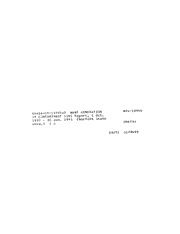
NASA Technical Reports Server (NTRS) 19940006474: Wave generation by contaminant ions PDF
Preview NASA Technical Reports Server (NTRS) 19940006474: Wave generation by contaminant ions
N9_-I0946 (NASA-CR-19355d) WAVE GENERATION _y CQNTAMINANT IONS Report, I Oct. 1992 - 30 Jun. 1993 (Norfolk State Uncl as Univ.) 5 p G3/?Z 0179#98 NASA-CR-193558 Preliminary Report (October 1, 1992 to June 30, 1993) Wave Generation by Contaminant Ions Grant # NAG3-1371 P. I. :Dr. N. Singh Over the grant period from October 1, 1992 to June 30, 1993 we performed the following investigations dealing with the generation of waves by contaminant ions. (1) Contaminant Ions Distribution Function: The properties of velocity distribution function of the contaminant ions were studied. Such ions are produced by charge exchange between ionospheric O+ ions and the contaminant molecules and atoms, such as water (H20). We followed the trajectories of a large number of H2 O+ ions in a magnetic field. The initial velocity of the ions was chosen to be 8 bn/s, which is the typical orbital velocity at the shuttle altitudes. The molecules and atoms released fi'om the shuttle move with the orbital velocity with respect to the ionospheric plasma. We find that it takes about one ion-cyclotron period for the distribution function to transform from a beam (Figure la) to a ring distribution (Figure lc). (2) Linear Instability Analysis: We performed linear instability analysis to examine the possibility of wave excitation by an ion beam streaming perpendicular to the ambient magnetic field in an ionospheric type of plasma. The frequency spectrum over which growth of waves is likely to occur was determined parametrically depending on the relative density of the ion beam. We found growth can occur for frequencies which are a sizable fraction of the ion-plasma frequency which can be as high as 50 kHz in the ionosphere. Figure 2a shows the wave frequency normalized to the ambient ion-plasma frequency (copo) as a function of normalized wave number kx in units of COpo/1Io where Vo is the orbital velocity. This figure is for Y = cope/-Oe = 3, where COpe and .(2e are the electron plasma and cyclotron frequencies, respectively. The result shown is for propagation in a direction (0= 0) perpendicular to the magnetic field. Calculations have been performed for an appropriate range of 0. The corresponding growth rates (Im(CO)) of the waves are shown in Figure 2b. The growth rates are normalized to COpo. The different curves in Figures 2a and 2b are for the relative densities of the water ions with respect to the ambient plasma density. It is seen that for a low beam density, the waves with the maximum growth rate have frequencies which are about 33% of the ion- plasma frequencies. For an ambient ion density of <106 cm -3, fpo = COpo/2 n:< 50 kHz, making it possible for the excited waves to reach up to 17 kHz. It is also worth noting that the waves with maximum growth rates have nearly the maximum frequencies in curves for Re(CO) versus kx (Figure 2a); the maximum growth rate occurs near the peak of such curves. (3) 2 1/2-Dimensional PIC Code: We developed a 2 1/2-dimensional PIC simulation code to study the nonlinear behavior of the waves excited by beam and ring types of ion distributions. The code treats both electrons and ions as particles. Since lower-hybrid waves may be involved, it is essential that both the particle species be treated kinetically. 2 (4) Nonlinear Studies of the Waves: We have performed initial simulation runs showing the excitation and saturation of the excited waves. In order to reach firm conclusions about the nonlinear behavior of the waves, a systematic set of runs need to be performed by varying the parameters of the problem such as the relative densities of the beam and the ambient plasma and the plasma temperatures. We are in the process of performing such simulations. 10 [ ! I ! m E F (a) - _-_ 0 - > D I I I , I 0 10 Vx (km/s) I0 [ ' [ i | E >0 _ -I0 - i 1 I I -i0 0 i0 20 Vx (km/s) i J f (d) [ I ,I i 0 i0 20 Vx (km/s) Figure 1: Phase-space plots of ions produced by charge exchange. (a) At a very early time t - 1L_el, we see a beam-are type of distribution. As more and more ions are produced, the beam-arc evolves into a ring distribution as shown in (b) and (c) for t= 5 K'_'el and 12 ._e 1, respectively. y=3.0 0=0 0.40 I I I (a) a=O.1 0.32 a=05 ................ a =0.75 ....... f '. a =0 9 ....... a=0.95 ..... 0.24 3 / / \ : / 0.16 ...:.l".// ,/I,t ". -- : / i'1 \ -" ...................................... 0.08 :' .I / / \ I / ,/// .: / // ,/'//i/ 0.00 .'/ I 1 I O0 0.6 1.2 18 2.4 k, I I I .•."'.... (b) .: ._. '. 0.096 .: I \ '. 0"120 t ."/ "\ ".,. /i "_" "i '_ " i _" o.0?2 !l" , 3 ,,..¢ I:!l ii,"l ,?_ '_i:!. iZ,' ii o.o;. "ili , ii ill _i 0.000 _1 li I 1 0.0 0.6 1.2 1.8 2.4 k, as a function of kx, the Figure 2: (a) Real part of the wave frequency (Re(a_)) normalized wave number measured in units of eOpo / Vo, where eopo is the ambient ion plasma frequency and 7o is the orbital velocity which is the initial velocity of water ions as they are released in the ionosphere. The curves shown are for different values of the normalized water ion densities. (b) The wave growth rates for the same parameter as in Figure 2a. The growth rate (Im(co)) is given in units of rOpo. Note that the growth rate maximizes for a relative density _: = 0.5, i.e., when water and oxygen ion densities are the same.
